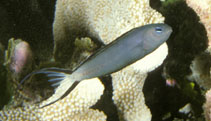| Family: |
Blenniidae (Combtooth blennies), subfamily: Blenniinae |
| Max. size: |
|
| Environment: |
reef-associated; marine; depth range 3 - 12 m |
| Distribution: |
Western Central Pacific. |
| Diagnosis: |
Dorsal spines (total): 4-4; Dorsal soft rays (total): 27-27; Anal spines: 2-2; Anal soft rays: 17-17. Lunate caudal fin with elongated lobes; body coloration bluish gray, shading to white posteriorly and unto middle base of caudal fin; thin bluish gray margin and broad, black submarginal band on dorsal fin; anal fin black; caudal fin lobes black with membrane between transparent with pale bluish gray rays. Segmented caudal rays 11; lateral line present (Ref. 54980). |
| Biology: |
Oviparous. Eggs are demersal and adhesive (Ref. 205), and are attached to the substrate via a filamentous, adhesive pad or pedestal (Ref. 94114). Larvae are planktonic, often found in shallow, coastal waters (Ref. 94114). Minimum depth from Ref. 58018. |
| IUCN Red List Status: |
Data deficient (DD); Date assessed: 28 March 2009 Ref. (130435)
|
| Threat to humans: |
harmless |
Source and more info: www.fishbase.org. For personal, classroom, and other internal use only. Not for publication.

